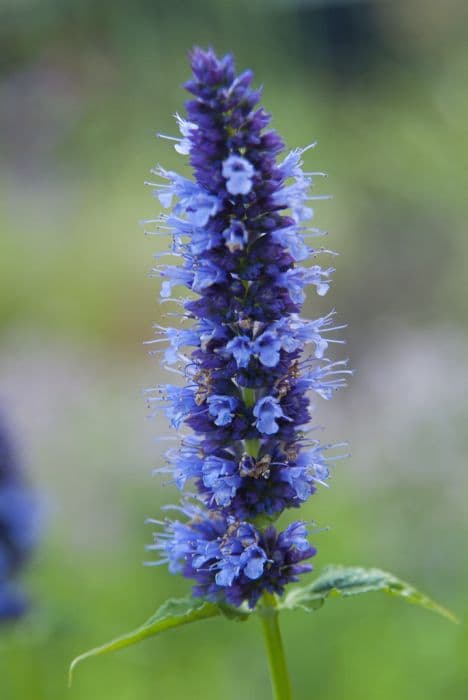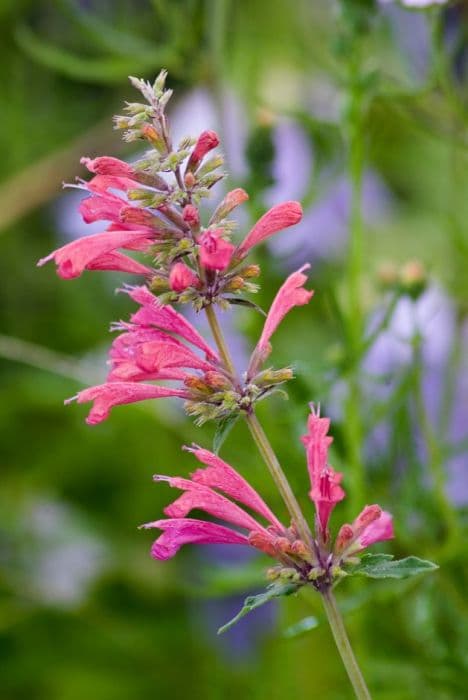French Lavender Lavandula pedunculata subsp. sampaiana 'Purple Emperor'

ABOUT
The plant known as the 'Purple Emperor' is an attractive variety that showcases striking violet-blue flowers. These blooms are noted for their elongated, slender petals that create a delicate and whimsical appearance, often compared to small butterflies hovering atop the green foliage. The flowers form dense, elongated spike-like clusters that extend upwards, giving a sense of verticality and grace to the plant's overall form. The greenery that accompanies these flowers is equally compelling, made up of aromatic leaves that emit a pleasant fragrance when disturbed or brushed against. The leaves are typically narrow and lance-shaped, presenting a grayish-green hue that contrasts elegantly with the vibrant tones of the blossoms. The plant's overall form is bushy and spreading, possessing a natural rounded shape that often looks neat with minimal pruning. As it blooms, the 'Purple Emperor' can become a focal point in gardens due to its rich coloration and textured foliage. The blooms often attract bees and butterflies, adding to the dynamic and lively presence of the plant in an outdoor setting. In summary, the 'Purple Emperor' is a visually appealing plant with colorful, fragrant flowers and soft, aromatic foliage, offering dual sensory delights of sight and smell, minus the quantified dimensions.
About this plant
 Names
NamesFamily
Lamiaceae
Synonyms
French Lavender, Butterfly Lavender, Purple Emperor Lavender
Common names
Lavandula pedunculata subsp. sampaioana 'Purple Emperor'.
 Toxicity
ToxicityTo humans
Lavender, in general, is not considered toxic to humans. The Spanish lavender, specifically 'Purple Emperor', is primarily grown for ornamental purposes and is often used in aromatherapy and herbal remedies, suggesting that it has a wide margin of safety for human use. However, like many plants, it may cause mild discomfort if ingested in large quantities, potentially leading to symptoms such as nausea, vomiting, or abdominal pain. It is also important to note that some people may have allergic reactions to lavender if they are sensitive to it. Nonetheless, it is not typically classified as a poisonous plant to humans.
To pets
Spanish lavender, commonly just called lavender, is generally regarded as safe for pets. It is not considered to be toxic to cats and dogs. However, ingestion of large amounts of lavender may cause mild gastrointestinal upset in some pets. If a pet consumes a significant quantity of lavender, symptoms like vomiting or diarrhea may occur. Since each pet is individually different, monitoring for any adverse reactions if ingestion occurs is sensible, and consulting with a veterinarian if any concerning symptoms develop is recommended.
 Characteristics
CharacteristicsLife cycle
Perennials
Foliage type
Evergreen
Color of leaves
Green
Flower color
Purple
Height
2 feet [60 cm]
Spread
2 feet [60 cm]
Plant type
Shrub
Hardiness zones
8
Native area
Mediterranean
Benefits
 General Benefits
General Benefits- Aesthetic Appeal: Adds vibrant purple color and unique texture to gardens and landscapes.
- Fragrance: Produces a strong, pleasant lavender scent that can create a calming atmosphere in outdoor spaces.
- Drought Tolerance: Highly adaptable to dry conditions, reducing the need for frequent watering.
- Low Maintenance: Requires minimal care once established, making it ideal for gardeners of all skill levels.
- Attracts Pollinators: Serves as an attractant for bees, butterflies, and other beneficial pollinators, supporting biodiversity.
- Culinary Uses: Flowers and leaves can be used in various culinary preparations for their aromatic properties.
- Decorative Uses: Both fresh and dried flowers can be used in bouquets, wreaths, and other decorative arrangements.
- Companion Planting: Can be planted alongside other species to enhance the overall health and productivity of a garden.
 Medical Properties
Medical Properties- Antiseptic: The essential oils in Lavandula pedunculata (commonly known as French Lavender) have antiseptic properties.
- Anti-inflammatory: It may reduce inflammation when applied topically as an infused oil.
- Antibacterial: French Lavender has been known to possess antibacterial activity.
- Anxiolytic: May have a calming effect on the nervous system, potentially reducing anxiety when its aroma is inhaled.
- Antispasmodic: Can diminish muscle spasms; often used in aromatherapy for relaxation.
- Sedative: May help promote sleep or alleviate symptoms of insomnia through inhalation of the essential oil.
 Air-purifying Qualities
Air-purifying QualitiesThis plant is not specifically known for air purifying qualities.
 Other Uses
Other Uses- Culinary flavoring: The flowers and leaves can be used to infuse sugars or salts, adding a floral touch to desserts or savory dishes.
- Crafting potpourris: Dried blossoms of the French lavender are commonly included in potpourris for their long-lasting fragrance and appealing color.
- Natural moth repellent: Dried French lavender bags can be placed in wardrobes or drawers to deter moths and keep clothes smelling fresh.
- Aromatherapy: The essential oil or dried flowers are used in aromatherapy practices for relaxation and as a sleep aid.
- Bath additive: Fresh or dried blooms can be added to baths to create a soothing and fragrant experience.
- Decorative wreaths: French lavender can be woven into wreaths and dried flower arrangements for long-lasting home decor.
- Herbal pillows: Small pillows or sachets filled with dried lavender flowers can be used to promote relaxation and better sleep.
- Garden companion planting: French lavender is often planted alongside vegetables to attract pollinators and deter harmful insects.
- Landscape design: Due to its hardiness and attractive foliage, French lavender is used to accent rock gardens and xeriscapes.
- Floral water: Hydrosols made from the distillation of French lavender are used as gentle facial toners or linen sprays.
Interesting Facts
 Feng Shui
Feng ShuiThe plant Lavender is not used in Feng Shui practice.
 Zodiac Sign Compitability
Zodiac Sign CompitabilityLavender is not used in astrology practice.
 Plant Symbolism
Plant Symbolism- Calmness and tranquility: Lavender is widely known for its calming scent, which is used in aromatherapy to reduce stress, anxiety, and promote relaxation.
- Healing: Historically, lavender has been associated with healing, both physically and spiritually, due to its medicinal properties.
- Purity and cleanliness: With its fresh and clean aroma, lavender is often connected to the idea of purity and the cleansing of one’s soul or environment.
- Devotion and loyalty: In some cultures, lavender represents devotion, constancy, and undying loyalty.
- Silence and peace: The tranquil nature of lavender makes it a symbol for silence and peacefulness, often used in places seeking to provide a retreat from noise and chaos.
- Grace and elegance: Due to its beautiful appearance and fragrance, lavender is also associated with grace, elegance, and refinement.
- Protection: Folklore suggests that lavender can ward off evil spirits or negativity, making it a plant of protection.
 Water
WaterThe Lavender 'Purple Emperor' should be watered deeply but infrequently, allowing the soil to dry out between waterings. Typically, watering once every 1 to 2 weeks is sufficient, but this can vary due to climate and soil conditions. In hotter, drier conditions, more frequent watering may be necessary. When you do water, aim to use about 1 gallon of water per plant to ensure it reaches the deep roots. Always avoid overwatering, as lavender prefers drier conditions and is susceptible to root rot with excessive moisture.
 Light
LightThe 'Purple Emperor' Lavender thrives best in full sun conditions with at least 6 to 8 hours of direct sunlight daily. This plant is ideally placed in an unshaded spot where it can receive plenty of sunlight throughout the day. Partial shade can be tolerated, but full sunlight encourages the best growth and flowering.
 Temperature
TemperatureThe 'Purple Emperor' Lavender is hardy and can tolerate a range of temperatures but grows best in conditions between 60°F and 70°F. It can withstand temperatures down to about 10°F, and up to 90°F, but extreme heat or cold can be detrimental to its growth and blooming. Ensure it's planted in an area that avoids the harsh winter cold or the extreme summer heat.
 Pruning
PruningPruning is vital for the 'Purple Emperor' Lavender to maintain its shape and promote vigorous growth. Prune once a year, ideally in the late summer after the blooms have faded or in early fall, cutting back about a third of the plant's height. Avoid cutting into the woody part of the stems, as this can damage the plant. Pruning not only encourages new growth for the next season but also prolongs the life of the lavender plant.
 Cleaning
CleaningNot needed
 Soil
SoilPortuguese Lavender (Lavandula pedunculata subsp. sampaiana 'Purple Emperor') thrives in a well-draining soil mix composed of 2 parts coarse sand or perlite to 1 part compost or peat moss. The pH for optimal growth should be slightly alkaline, around 6.5 to 7.5.
 Repotting
RepottingPortuguese Lavender typically requires repotting every 2 to 3 years to ensure the soil remains well-draining and to refresh the nutrient levels in the potting mix.
 Humidity & Misting
Humidity & MistingPortuguese Lavender prefers a dry environment and does well in typical indoor humidity levels. It is well adapted to the low-humidity conditions found in Mediterranean climates.
 Suitable locations
Suitable locationsIndoor
Place in full sun with good air circulation.
Outdoor
Plant in full sun, well-draining soil.
Hardiness zone
7-9 USDA
 Life cycle
Life cycleLavandula stoechas 'Purple Emperor', commonly known as Butterfly Lavender or French Lavender, begins its life cycle when seeds germinate in spring, ideally in well-draining, slightly alkaline soil with ample sunlight. Seedlings emerge, developing into young plants with characteristic narrow, grey-green leaves. As the plants mature through their vegetative stage, they form dense shrubs and by early to mid-summer, they start producing long-stalked purple flower heads topped with petal-like purple bracts that resemble butterflies, attracting pollinators. After pollination, the flowers produce seeds that can be dispersed by wind or wildlife. Post-blooming, pruning is crucial to maintaining a compact shape and encouraging new growth. In winter, the plant experiences dormancy, with reduced growth, allowing it to conserve energy and prepare for the next growing cycle in spring.
 Propogation
PropogationPropogation time
Spring to early summer
The Lavender 'Purple Emperor', scientifically known as Lavandula pedunculata subsp. sampaiana 'Purple Emperor', is commonly propagated by softwood cuttings. The suitable time for propagation is late spring or early summer when new growth is abundant and the temperatures are conducive to root development. To propagate through cuttings, a gardener would typically select a healthy, non-flowering stem and cut a 3 to 4-inch (7.6 to 10.2 cm) length, making sure there are several leaf nodes present. The lower leaves are removed, and the cut end is dipped in rooting hormone to facilitate root growth. The cutting is then placed in a well-draining soil mix, kept moist, and placed in a warm area with indirect sunlight. Roots generally begin to form in a few weeks, after which the new lavender plant can eventually be transplanted outdoors.





![Bugle [Sugar Plum]](/_next/image?url=https%3A%2F%2Fplants-admin.emdemapps.com%2Fimages%2Fplants%2F%2Fimages%2F604b597956a55.png&w=640&q=75)
![Bugle [Princess Nadia]](/_next/image?url=https%3A%2F%2Fplants-admin.emdemapps.com%2Fimages%2Fplants%2F%2Fimages%2F604b5806e268c.png&w=640&q=75)


